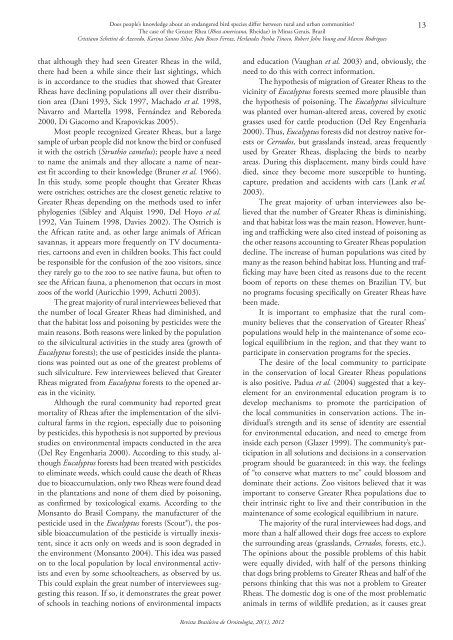Capa 20(1) - fechada.indd - Sociedade Brasileira de Ornitologia
Capa 20(1) - fechada.indd - Sociedade Brasileira de Ornitologia
Capa 20(1) - fechada.indd - Sociedade Brasileira de Ornitologia
Create successful ePaper yourself
Turn your PDF publications into a flip-book with our unique Google optimized e-Paper software.
Does people’s knowledge about an endangered bird species differ between rural and urban communities?The case of the Greater Rhea (Rhea americana, Rheidae) in Minas Gerais, BrazilCristiano Schetini <strong>de</strong> Azevedo, Karina Santos Silva, João Bosco Ferraz, Herlan<strong>de</strong>s Penha Tinoco, Robert John Young and Marcos Rodrigues13that although they had seen Greater Rheas in the wild,there had been a while since their last sightings, whichis in accordance to the studies that showed that GreaterRheas have <strong>de</strong>clining populations all over their distributionarea (Dani 1993, Sick 1997, Machado et al. 1998,Navarro and Martella 1998, Fernán<strong>de</strong>z and Reboreda<strong>20</strong>00, Di Giacomo and Krapovickas <strong>20</strong>05).Most people recognized Greater Rheas, but a largesample of urban people did not know the bird or confusedit with the ostrich (Struthio camelus); people have a needto name the animals and they allocate a name of nearestfit according to their knowledge (Bruner et al. 1966).In this study, some people thought that Greater Rheaswere ostriches; ostriches are the closest genetic relative toGreater Rheas <strong>de</strong>pending on the methods used to inferphylogenies (Sibley and Alquist 1990, Del Hoyo et al.1992, Van Tuinem 1998, Davies <strong>20</strong>02). The Ostrich isthe African ratite and, as other large animals of Africansavannas, it appears more frequently on TV documentaries,cartoons and even in children books. This fact couldbe responsible for the confusion of the zoo visitors, sincethey rarely go to the zoo to see native fauna, but often tosee the African fauna, a phenomenon that occurs in mostzoos of the world (Auricchio 1999, Achutti <strong>20</strong>03).The great majority of rural interviewees believed thatthe number of local Greater Rheas had diminished, andthat the habitat loss and poisoning by pestici<strong>de</strong>s were themain reasons. Both reasons were linked by the populationto the silvicultural activities in the study area (growth ofEucalyptus forests); the use of pestici<strong>de</strong>s insi<strong>de</strong> the plantationswas pointed out as one of the greatest problems ofsuch silviculture. Few interviewees believed that GreaterRheas migrated from Eucalyptus forests to the opened areasin the vicinity.Although the rural community had reported greatmortality of Rheas after the implementation of the silviculturalfarms in the region, especially due to poisoningby pestici<strong>de</strong>s, this hypothesis is not supported by previousstudies on environmental impacts conducted in the area(Del Rey Engenharia <strong>20</strong>00). According to this study, althoughEucalyptus forests had been treated with pestici<strong>de</strong>sto eliminate weeds, which could cause the <strong>de</strong>ath of Rheasdue to bioaccumulation, only two Rheas were found <strong>de</strong>adin the plantations and none of them died by poisoning,as confirmed by toxicological exams. According to theMonsanto do Brasil Company, the manufacturer of thepestici<strong>de</strong> used in the Eucalyptus forests (Scout®), the possiblebioaccumulation of the pestici<strong>de</strong> is virtually inexistent,since it acts only on weeds and is soon <strong>de</strong>gra<strong>de</strong>d inthe environment (Monsanto <strong>20</strong>04). This i<strong>de</strong>a was passedon to the local population by local environmental activistsand even by some schoolteachers, as observed by us.This could explain the great number of interviewees suggestingthis reason. If so, it <strong>de</strong>monstrates the great powerof schools in teaching notions of environmental impactsand education (Vaughan et al. <strong>20</strong>03) and, obviously, theneed to do this with correct information.The hypothesis of migration of Greater Rheas to thevicinity of Eucalyptus forests seemed more plausible thanthe hypothesis of poisoning. The Eucalyptus silviculturewas planted over human-altered areas, covered by exoticgrasses used for cattle production (Del Rey Engenharia<strong>20</strong>00). Thus, Eucalyptus forests did not <strong>de</strong>stroy native forestsor Cerrados, but grasslands instead, areas frequentlyused by Greater Rheas, displacing the birds to nearbyareas. During this displacement, many birds could havedied, since they become more susceptible to hunting,capture, predation and acci<strong>de</strong>nts with cars (Lank et al.<strong>20</strong>03).The great majority of urban interviewees also believedthat the number of Greater Rheas is diminishing,and that habitat loss was the main reason. However, huntingand trafficking were also cited instead of poisoning asthe other reasons accounting to Greater Rheas population<strong>de</strong>cline. The increase of human populations was cited bymany as the reason behind habitat loss. Hunting and traffickingmay have been cited as reasons due to the recentboom of reports on these themes on Brazilian TV, butno programs focusing specifically on Greater Rheas havebeen ma<strong>de</strong>.It is important to emphasize that the rural communitybelieves that the conservation of Greater Rheas’populations would help in the maintenance of some ecologicalequilibrium in the region, and that they want toparticipate in conservation programs for the species.The <strong>de</strong>sire of the local community to participatein the conservation of local Greater Rheas populationsis also positive. Padua et al. (<strong>20</strong>04) suggested that a keyelementfor an environmental education program is to<strong>de</strong>velop mechanisms to promote the participation ofthe local communities in conservation actions. The individual’sstrength and its sense of i<strong>de</strong>ntity are essentialfor environmental education, and need to emerge frominsi<strong>de</strong> each person (Glazer 1999). The community’s participationin all solutions and <strong>de</strong>cisions in a conservationprogram should be guaranteed; in this way, the feelingsof “to conserve what matters to me” could blossom anddominate their actions. Zoo visitors believed that it wasimportant to conserve Greater Rhea populations due totheir intrinsic right to live and their contribution in themaintenance of some ecological equilibrium in nature.The majority of the rural interviewees had dogs, andmore than a half allowed their dogs free access to explorethe surrounding areas (grasslands, Cerrados, forests, etc.).The opinions about the possible problems of this habitwere equally divi<strong>de</strong>d, with half of the persons thinkingthat dogs bring problems to Greater Rheas and half of thepersons thinking that this was not a problem to GreaterRheas. The domestic dog is one of the most problematicanimals in terms of wildlife predation, as it causes greatRevista <strong>Brasileira</strong> <strong>de</strong> <strong>Ornitologia</strong>, <strong>20</strong>(1), <strong>20</strong>12
















